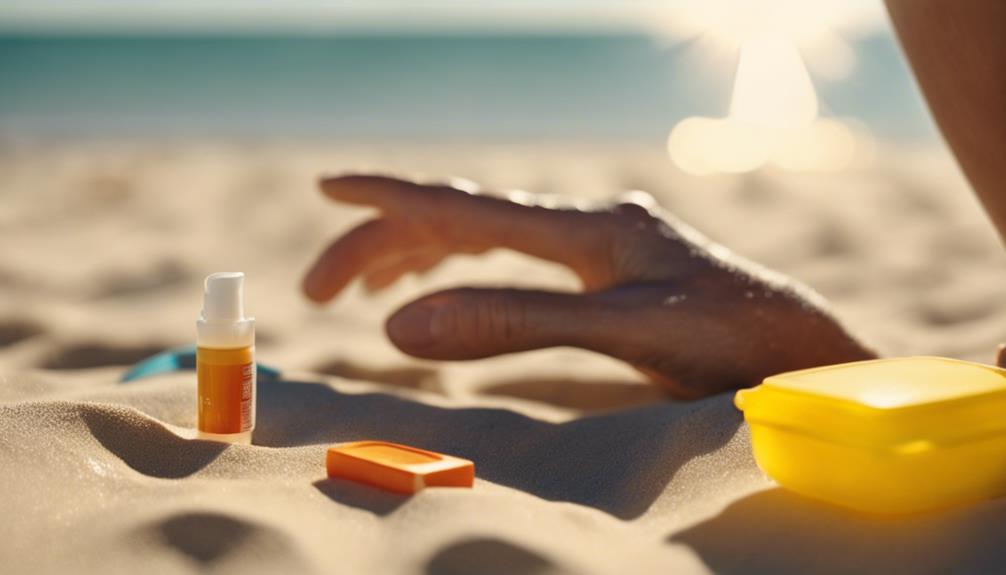Scientists recently discovered the HAL gene, essential for your skin's natural sun protection. It helps absorb UVB rays and boosts vitamin D production while guarding against UV damage. Variations in this gene can affect how efficiently your body protects itself from the sun. You might be wondering if you have this gene and what it means for your skin health. At-home genetic testing kits are available to analyze your DNA for this and other related genes. Understanding your genetic predispositions can empower you to personalize your sun safety strategies, and there's plenty more to explore on this topic.
Key Takeaways
- The HAL gene acts as an internal sunscreen, absorbing UVB rays and enhancing vitamin D production.
- Genetic testing can reveal variations in the HAL gene, indicating your ability to synthesize vitamin D and resist UV damage.
- At-home genetic testing kits provide insights into your skin's response to UV radiation and potential susceptibility to skin cancer.
- Melanin production and skin tone, influenced by genetics, affect your natural defense against UV radiation exposure.
Breakthrough Genetic Discovery
Researchers have uncovered the HAL gene, which acts as an internal sunscreen by absorbing UVB rays and boosting vitamin D production while protecting against UV damage. This breakthrough discovery highlights the role of the so-called sunproof gene in human genetics.
You might find it fascinating that a study involving over 502,000 individuals in the U.K. revealed variations in the HAL gene associated with enhanced vitamin D synthesis. This challenges previous beliefs about how skin color influenced vitamin D levels.
The significant identification of 143 gene locations related to vitamin D concentration further emphasizes the complexity of our genetic responses to sun exposure. These findings suggest that you may possess genetic advantages that allow for better vitamin D production and UV protection, regardless of your skin type.
As researchers investigate deeper into the implications of the HAL gene, they're also exploring potential treatments that may harness this genetic insight. Imagine a future where gene therapy could enhance your skin's natural defenses against UV damage, stemming from the understanding of the sunproof gene.
This discovery not only sheds light on genetic variations but also opens doors for innovative approaches to health and wellness.
Understanding the Sunproof Gene

You'll want to understand how genetic mechanisms work to protect your skin from UV damage.
The role of melanin and its variations can greatly impact your vulnerability to sun exposure.
Genetic Mechanisms of Protection
Understanding the genetic mechanisms behind skin protection reveals how specific genes, like UVRAG and HAL, play vital roles in defending against UV damage and reducing skin cancer risk.
The UVRAG gene acts as a tumor suppressor, repairing DNA damage caused by UV radiation. Lower levels of UVRAG are linked to poorer survival rates in melanoma patients, highlighting its importance in skin cancer prevention.
On the other hand, the HAL gene influences the production of an internal sunscreen gene, which absorbs harmful UVB light while facilitating vitamin D synthesis. This internal protection mechanism adds another layer of defense against skin cancer. Notably, research has identified 143 gene locations connected to vitamin D concentration, illustrating the complexity of genetic factors at play.
Additionally, variants in the MC1R gene can affect how your skin responds to sunlight, further contributing to differences in susceptibility to UV damage among different populations.
These genetic insights are essential for understanding why some people are more prone to skin cancer than others, emphasizing the need for personalized approaches to sun protection based on genetic makeup.
Role of Melanin
Melanin serves as your skin's natural defense against UV radiation, providing varying levels of protection based on genetic factors and skin tone. It's a pigment produced in the skin, and individuals with darker skin tones typically have higher melanin levels, which greatly reduces their risk of UV damage. When your skin is exposed to sunlight, melanin production ramps up as a protective response, absorbing and dissipating harmful rays.
However, genetic variations can influence how efficiently your body synthesizes melanin. This means that some people may be more susceptible to UV damage due to lower melanin production.
Research indicates that melanin isn't just a shield against UV rays but also plays a vital role in vitamin D synthesis. Different skin types produce vitamin D at varying rates, influenced by melanin concentration.
Additionally, environmental factors like geographic location and lifestyle choices interact with these genetic predispositions, affecting overall skin health.
Understanding your melanin levels and how they relate to your skin tone can help you make informed decisions about sun protection and skincare, ensuring you maintain both health and radiance.
Activation of Your Sunproof Gene

Activating your sunproof gene hinges on the balance between UV exposure and your skin's protective responses. The HAL gene plays an important role in this process, producing a molecule that absorbs UVB rays, functioning as an internal SPF. This gene not only helps shield your skin but also aids in vitamin D synthesis.
To effectively activate your sunproof gene, it's vital to manage your time in the sun. Research shows that your skin has a production limit for vitamin D. Once you reach that limit, prolonged exposure won't increase vitamin D levels and can lead to skin damage. As a result, finding that sweet spot between getting enough sunlight for vitamin D and avoiding overexposure is key.
Environmental factors also influence the activation of your sunproof gene. Increased UV exposure stimulates the gene's expression, promoting greater melanin production, which enhances your skin's natural protection.
Understanding your genetic predisposition to sun protection can help you personalize your sun safety strategies. This could include using sunscreen and considering vitamin D supplementation, depending on your lifestyle and sun exposure habits.
At-Home Genetic Testing Methods

You can easily explore your genetic makeup with at-home testing kits designed for sun sensitivity.
These kits typically involve a simple saliva or cheek swab collection process.
Once you get your results, understanding your genetic predisposition to skin protection can help you make informed decisions about sun exposure and care.
Testing Kits Overview
At-home genetic testing kits offer a convenient way to analyze your DNA for insights into sun sensitivity and skin cancer risk. These kits typically analyze saliva or cheek swabs to identify genetic variants linked to your response to UV radiation, such as MC1R and UVRAG. Within a few weeks, you can receive results detailing your genetic predispositions related to sun exposure and vitamin D synthesis.
When choosing a testing kit, consider the following factors:
| Feature | Importance | Examples |
|---|---|---|
| Genetic Variants | Identifies sun sensitivity genes | MC1R, UVRAG |
| Result Timeframe | Quick turnaround for insights | Usually within weeks |
| Recommendations | Tailored sun protection strategies | SPF suggestions, lifestyle tips |
Selecting a reputable company guarantees compliance with regulations and scientifically-backed interpretations of your genetic data. By understanding your skin cancer risk, you can make informed decisions about sun protection and overall skin health.
Sample Collection Process
To guarantee accurate DNA analysis, participants typically need to follow specific instructions for collecting a saliva sample using the provided kit. This non-invasive method simplifies the sample collection process and guarantees that you can easily carry it out at home.
To get the best results from your genetic testing, keep these tips in mind:
- Avoid food and drink: Refrain from eating or drinking for at least 30 minutes before collecting your sample. This helps to prevent contamination and guarantees the purity of your DNA.
- Follow the kit instructions: Each kit comes with detailed instructions. Make sure to read and follow them closely to avoid any mistakes during the sample collection.
- Seal and send: Once you've collected your saliva, securely seal the collection tube and mail it back to the designated laboratory for analysis.
After your sample is sent, the lab will extract and assess your genomic data for specific markers related to skin health and sun protection. This process allows you to gain valuable insights into how your genetics influence your skin's response to UV exposure.
Interpreting Genetic Results
Interpreting the genetic results from your saliva sample reveals significant insights about your skin's response to sun exposure and potential risks for skin health. Through at-home genetic testing, you can discover how your genes influence sun sensitivity and melanin production. For instance, variations in genes like UVRAG may indicate your susceptibility to skin cancer, helping you make informed decisions about sun protection.
Additionally, these tests often provide information on how your body metabolizes vitamin D, an essential nutrient synthesized through sun exposure. Understanding your genetic predisposition can guide you in optimizing your vitamin D levels, whether by adjusting your diet or modifying your sun exposure habits.
Many at-home testing kits offer personalized recommendations based on your genetic results. You might receive tailored advice on sunscreen usage, suggesting specific SPF levels or types that best suit your skin's needs.
It's important to remember, though, that your genetic makeup is just one piece of the puzzle. Always consider your overall health and lifestyle, as environmental factors and personal habits play significant roles in skin protection.
Products to Enhance Sun Protection

Explore a variety of products designed to enhance your sun protection, from broad-spectrum sunscreens to UPF-rated clothing. Protecting yourself from sun damage is essential, and incorporating the right products can make a significant difference.
Here are three must-have items to take into account:
- Broad-Spectrum Sunscreen: Choose a sunscreen with an SPF of 30 or higher to shield your skin from harmful UVA and UVB rays. Water-resistant options are particularly useful for outdoor activities and swimming.
- Antioxidant-Rich Skincare: Incorporating skincare products packed with antioxidants can help combat oxidative stress caused by UV exposure. These products can enhance your skin's natural defenses against sun damage.
- UPF-Rated Clothing: Look for clothing with a UPF rating to block a significant percentage of UV radiation. This extra layer of protection is invaluable during extended sun exposure.
The Role of Melanin in Protection

Melanin acts as your skin's natural shield, absorbing and reflecting UV radiation to reduce the risk of damage. This pigment, responsible for your skin color, plays an essential role in protecting you from harmful UV rays. When your skin is exposed to sunlight, it stimulates melanin production, which acts as a protective response against DNA damage in skin cells.
Individuals with darker skin tones have higher melanin concentrations, offering better protection against UV-induced skin damage. However, it's important to remember that this doesn't completely eliminate the risk of skin cancers. Genetic variations determine how much melanin your body produces, influencing your susceptibility to UV damage and skin cancer risk.
Environmental factors, like where you live and your sun exposure habits, also affect melanin expression. This means your skin's natural defense varies based on both genetics and lifestyle.
While melanin provides a valuable layer of protection, it's still essential to complement it with other sun safety measures, like wearing sunscreen. By understanding the role of melanin, you can better appreciate its importance in maintaining your skin's health and minimizing the risk of skin cancers.
Health Implications of Sun Exposure

When you spend time in the sun, you face risks like skin cancer, which affects many Americans each year.
However, sun exposure also plays a role in vitamin D production, which is essential for your health.
Understanding how genetics influence your response to UV rays can help you make informed decisions about sun safety.
Skin Cancer Risks
Prolonged sun exposure greatly raises your risk of skin cancer, making it essential to take protective measures like using sunscreen.
Skin cancer is the most common cancer in the U.S., affecting 1 in 5 Americans, and daily melanoma fatalities average around 20. The health implications of excessive sun exposure are severe, emphasizing the urgency of awareness and prevention.
To help you stay safe in the sun, consider these tips:
- Use Broad-Spectrum Sunscreen: Apply a broad-spectrum sunscreen with an SPF of at least 30, and reapply every two hours, especially if you're sweating or swimming.
- Seek Shade: Whenever possible, seek shade during peak sun hours, typically between 10 a.m. and 4 p.m.
- Wear Protective Clothing: Opt for long sleeves, wide-brimmed hats, and UV-blocking sunglasses to further reduce your skin cancer risks.
Vitamin D Production
Sun exposure plays a significant role in your body's ability to produce vitamin D, which is essential for maintaining overall health. The process involves skin-related genes, particularly variations in the HAL gene, that influence how effectively your skin can synthesize vitamin D. Research shows that individuals with certain HAL gene variations tend to have increased vitamin D production, challenging the notion that skin color solely determines vitamin D levels.
However, your skin has a limit on how much vitamin D it can produce. Prolonged sun exposure won't necessarily boost your levels further; instead, it may lead to oxidative stress and premature aging. This highlights the significance of finding a balance. Adequate vitamin D is crucial for managing inflammation, supporting bone health, and enhancing immune function, so you need to guarantee you're getting enough.
Even if you have favorable skin-related genes for vitamin D production, applying sunscreen daily is significant. While it protects you from harmful UV rays, it also helps prevent the risks associated with excessive sun exposure. Prioritizing both sun protection and vitamin D intake can keep you healthy and thriving.
Genetic Influences on Health
Genetic factors greatly shape how your body responds to sun exposure, influencing both your behavior and health outcomes related to UV rays. Your genetic predisposition can dictate not just how much time you spend in the sun, but also your risk for skin damage and conditions like skin cancer.
Here are three key points to reflect on about genetic influences on health:
- Sun-Seeking Behavior: Studies suggest that heritability estimates for sun-seeking behaviors exceed 58%, meaning your genes may draw you to more time outdoors, increasing your UV exposure.
- Cancer Risk: Prolonged sun exposure is a leading factor in skin cancer development, with 1 in 5 Americans facing this risk. Understanding your genetic background can help you assess your vulnerability.
- Skin Health: The HAL gene plays a significant role in your skin's natural SPF capabilities and vitamin D synthesis. Variations in this gene could affect how well your skin protects itself from harmful UV rays.
Being aware of these genetic factors can empower you to make informed decisions about sun exposure and health.
Myths About Genetic Sun Protection

Many people mistakenly believe that their genetic traits, like higher melanin levels, can eliminate the need for sunscreen, but that's simply not true. While having the so-called 'sunscreen gene' may influence skin cancer risk, it doesn't provide immunity against UV damage. Everyone, regardless of skin tone, is at risk for skin damage and skin cancer from prolonged sun exposure.
Here are some common myths about genetic sun protection:
| Myth | Truth |
|---|---|
| Higher melanin means you don't need sunscreen. | All skin types can suffer from UV damage. |
| Darker skin can produce unlimited vitamin D without protection. | Extended UV exposure leads to oxidative stress. |
| Genetic traits guarantee protection against skin cancer. | Genetic variations don't eliminate the need for sunscreen. |
Overlooking the importance of daily sunscreen application can put you at serious risk. Your genetic predisposition doesn't negate the harmful effects of excessive sun exposure. It's crucial to prioritize sun safety, regardless of your genetic background.
Recommendations for Sun Safety

To guarantee your skin stays protected from harmful UV radiation, it's vital to apply sunscreen daily, regardless of the weather. Dermatologists recommend using a sunscreen with a sun protection factor (SPF) of 30 or higher, reapplying every two hours, and after swimming or sweating.
Here are three essential tips to enhance your sun safety:
- Apply Generously: Use about one ounce of sunscreen for full body coverage. Don't forget areas like your ears, neck, and the top of your feet.
- Daily Routine: Make sunscreen application a part of your morning routine. Even on cloudy days, UV rays can penetrate through clouds, so don't skip it!
- Know Your Skin Tone: It's a common misconception that darker skin tones don't need sunscreen. All skin types can suffer from UV damage, so protection is essential, regardless of your complexion.
Additionally, make sure to perform regular skin checks to monitor for changes. Early detection of any abnormalities can greatly improve treatment outcomes for skin cancer.
Prioritize your skin's health, and enjoy the sun safely!
Future Research Directions

Researchers are diving into innovative gene-editing technologies to boost the skin's natural defenses against UV radiation, aiming to lower skin cancer rates. They're focusing on enhancing the protective functions of the UV radiation resistance-associated gene (UVRAG) in skin cells. By doing this, they hope to greatly reduce skin cancer incidence.
Future studies will also explore how genetic variations, like those in the HAL gene, interact with environmental factors such as UV exposure. This research aims to unravel their combined effects on vitamin D synthesis and overall skin health.
Additionally, scientists are developing pharmacological agents designed to stimulate UVRAG activity, which could improve DNA repair mechanisms in skin cells after UV damage. Longitudinal studies are in the pipeline to assess the gene-environment dynamics over time, paving the way for personalized medicine approaches in skin cancer prevention and treatment strategies.
Furthermore, ongoing investigations will evaluate the effectiveness of natural SPF molecules produced by the skin, examining their role alongside traditional sun protection strategies, including sunscreen and dietary supplements. These future directions hold promise for a more all-encompassing understanding of skin cancer prevention.
Frequently Asked Questions
How Do You Know if You Have the MC1R Gene?
To know if you have the MC1R gene, you can undergo genetic testing or check for traits like red hair or fair skin. Consulting a healthcare professional can help you understand your risk for sun sensitivity.
Does Everyone Have a Mutant Gene?
About 30% of people carry mutant gene variants affecting UV protection. Not everyone has these genetic adaptations, leading to varying susceptibility to skin damage. Your genetics greatly influence how well your skin can cope with UV exposure.
Does Your Body Produce Natural Sunscreen?
Your body does produce a natural sunscreen through the HAL gene, which helps absorb UVB light. However, it's still essential to apply external SPF daily for adequate protection against skin damage and cancer risk.
Are Sunburns Genetic?
Yes, sunburns can be genetic. Your skin tone and specific gene variants, like MC1R, influence how your body reacts to sunlight. Environmental factors also play a role in determining your sunburn susceptibility.
Does the Sunproof Gene Make People Immune to Sunburn?
Scientists are studying the possibility of a gene making kids sunburn immune. The Sunproof gene may offer protection against harmful UV rays, reducing the risk of sunburn and skin damage. While more research is needed, this genetic trait could lead to new ways of preventing sun-related illnesses.
Conclusion
In a world where the sun reigns supreme, revealing the sunproof gene could be your shield against its fierce rays.
As you explore genetic testing and protective products, think of yourself as the hero in your own story, armed with knowledge and tools for sun safety.
With ongoing research lighting the way, you're not just a bystander in the battle against UV damage; you're taking charge.
So, step into the sun with confidence and embrace your newfound power.









